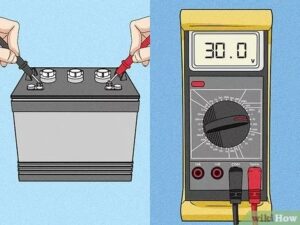Looking to learn how to make a lithium battery? You’re in the right place! In this article, we will guide you through the step-by-step process of creating your own lithium battery, from gathering the necessary materials to assembling the components. Whether you’re a DIY enthusiast or simply curious about the inner workings of these powerful and compact energy sources, this guide will provide you with all the information you need. So, let’s dive straight in and explore how to make a lithium battery from scratch.
How to Make a Lithium Battery: A Comprehensive Guide
The Basics of Lithium Batteries
Lithium batteries have revolutionized the portable electronics industry with their high energy density and long-lasting power. Whether you’re an electronics hobbyist or looking to develop your own products, understanding how to make a lithium battery can be a valuable skill. In this article, we’ll guide you through the process of making a lithium battery from scratch, covering everything from the required materials to the step-by-step assembly process.
Materials and Tools Needed
Before diving into the process of making a lithium battery, it’s important to gather all the necessary materials and tools. Here’s a list of what you’ll need:
- Lithium battery cells
- Battery management system (BMS)
- Battery holder or enclosure
- Nickel strips
- Spot welder
- Insulating tape
- Wire cutters/strippers
- Heat shrink tubing
- Soldering iron and solder
- Multimeter
- Protective gloves and safety glasses
Step-by-Step Guide
Now that you have all the necessary materials and tools, let’s dive into the step-by-step process of making a lithium battery:
Step 1: Prepare the Battery Cells
The first step is to prepare the lithium battery cells. Make sure to choose cells with the specific capacity and voltage requirements for your project. Here’s how to prepare the cells:
- Inspect each cell for any physical damage or leakage. Discard any damaged cells.
- Check the voltage of each cell using a multimeter. Ensure all cells have a similar voltage reading.
- Protect the terminals of each cell using insulating tape to prevent short circuits.
Step 2: Connect Battery Cells
Once the battery cells are ready, it’s time to connect them to form a battery pack. Follow these steps:
- Arrange the cells in the desired configuration (series or parallel) based on your voltage and capacity requirements.
- Use nickel strips to connect the positive terminal of one cell to the negative terminal of the next cell.
- Secure the connections by spot welding the nickel strips to the cell terminals. Ensure proper alignment and avoid excessive heat that could damage the cells.
- Repeat the process until all cells are connected, forming a battery pack.
Step 3: Install the Battery Management System (BMS)
To ensure the safe and optimal performance of your lithium battery, it’s crucial to install a battery management system. Here’s what you need to do:
- Choose a BMS suitable for your battery pack’s voltage and capacity.
- Follow the manufacturer’s instructions to install the BMS. Typically, this involves connecting the BMS to the positive and negative terminals of the battery pack and the load.
- Double-check all connections to ensure they are secure and properly insulated.
Step 4: Assemble the Battery Holder or Enclosure
To ensure the structural integrity and protection of your lithium battery, you’ll need to assemble a battery holder or enclosure. Here’s how:
- Choose a suitable battery holder or enclosure that can accommodate your battery pack.
- Secure the battery pack inside the holder or enclosure, ensuring it fits snugly and is well-protected.
- Verify that all wiring and connections are properly routed and insulated.
Step 5: Final Connections and Testing
With the physical assembly complete, it’s time to make the final connections and test your lithium battery. Follow these steps:
- Connect the BMS to any charging or discharging circuits, following the manufacturer’s instructions.
- Double-check all connections for proper polarity and insulation.
- Use a multimeter to test the voltage, current, and overall performance of your battery pack.
- Ensure the BMS is functioning correctly, monitoring and protecting the battery pack as intended.
Safety Considerations
When working with lithium batteries, it’s essential to prioritize safety. Here are some important safety considerations:
- Always wear protective gloves and safety glasses to prevent injury.
- Avoid exposing the battery cells to extreme temperatures or humidity.
- Never short-circuit the battery pack or expose it to excessive current.
- If using a spot welder, follow proper safety protocols and use appropriate protective equipment.
- Store and transport lithium batteries in a fireproof and secure container.
Congratulations! You’ve now learned how to make a lithium battery from scratch. By following the step-by-step guide and considering the safety precautions, you can create your own custom lithium battery packs for various applications. Remember to always practice caution and adhere to safety guidelines when working with lithium batteries. Now you’re equipped with the knowledge and skills to embark on your own battery-making journey!
Note: If you have any additional questions or need further assistance, please refer to the FAQ section.
Frequently Asked Questions
What are the basic steps involved in making a lithium battery?
1. Gathering materials: The first step is to gather all the necessary materials, including lithium, a metal oxide for the cathode, a conducting material for the electrolyte, and a suitable casing.
2. Mixing the materials: The materials are mixed together to create a slurry, ensuring that the lithium is evenly distributed throughout.
3. Coating: The slurry is applied onto a current collector, such as aluminum foil, and then dried to remove any solvents.
4. Assembly: Multiple coated sheets are stacked together, with separators in between to prevent short-circuiting.
5. Sealing: The stacked layers are then sealed in a casing, often made of steel or aluminum, to prevent leakage and protect the battery.
6. Electrolyte filling: The electrolyte, a substance that allows ions to move between the electrodes, is filled into the casing.
7. Final assembly: The battery is completed by adding terminals and connecting them to the electrodes.
What safety precautions should be taken when making a lithium battery?
When making a lithium battery, it is important to follow proper safety precautions to avoid accidents:
– Work in a well-ventilated area to prevent the accumulation of any hazardous fumes.
– Wear appropriate protective gear, such as gloves and safety glasses, to minimize the risk of chemical exposure.
– Handle lithium and other reactive materials with care, as they can be highly flammable and reactive.
– Avoid short-circuits by ensuring proper insulation and separation of the battery components.
– Dispose of any waste materials, such as solvents or excess electrolyte, according to local regulations.
What are the common challenges in making lithium batteries?
Making lithium batteries can come with several challenges, including:
– Obtaining high-quality lithium: The availability and quality of lithium can vary, making it important to source it from reliable suppliers.
– Ensuring consistent performance: Achieving consistent performance across multiple battery cells can be a challenge, as slight variations in the manufacturing process can affect performance.
– Managing safety risks: Lithium batteries can be prone to overheating and even catching fire in certain conditions, requiring careful handling and safety precautions.
– Balancing energy density and stability: Increasing the energy density of lithium batteries can make them more prone to instability and decreased lifespan, requiring careful optimization.
Can lithium batteries be made at home?
Making lithium batteries at home can be a complex and potentially dangerous process. Due to the hazardous nature of the materials and the precision required in the manufacturing process, it is generally recommended to rely on professional manufacturing facilities for lithium battery production. Attempting to make lithium batteries at home without the appropriate knowledge and equipment can present serious safety risks.
Final Thoughts
Making a lithium battery involves a series of steps. First, gather the necessary materials such as lithium, metal oxides, and a non-aqueous electrolyte. Next, prepare the electrodes by coating the metal oxide onto a conductive material. Assemble the battery by placing the electrodes and separator in a casing, and injecting the electrolyte. Finally, seal the battery and test its performance. Overall, the process of making a lithium battery requires careful material selection, precise assembly, and thorough testing. By following these steps, you can create your own lithium battery successfully. So, if you’re wondering how to make a lithium battery, simply follow these steps and enjoy the advantages it offers.



